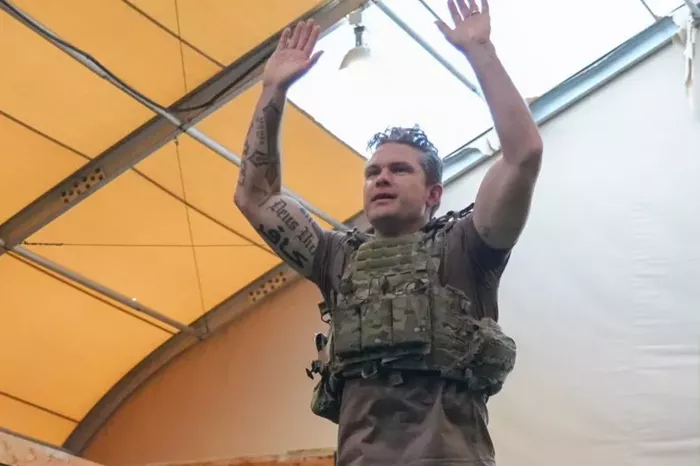U.S. Secretary of Defense Pete Hegseth has sparked controversy following the unveiling of a new tattoo on his right forearm, which reads “كافر” (kafir) in Arabic. The term, translating to “infidel” or “nonbeliever,” drew immediate attention and criticism after it was first visible on Wednesday during his visit to Joint Base Pearl Harbor-Hickam in Hawaii. Photos shared by the Secretary of Defense’s official social media account showing Hegseth interacting with soldiers led to widespread discussion, with several social media users pointing out the tattoo and accusing him of Islamophobia.
Newsweek reached out to the Pentagon for comment on the issue, but no official statement was made.
The Context of the Tattoo
Hegseth, a public Christian, has openly expressed his religious beliefs throughout his career, both in his personal life and professional endeavors. His tattoos, which he considers extensions of his faith and worldview, reflect this connection. Among his other tattoos are “Deus Vult” (“God wills it”) on his bicep—a reference to the First Crusade—a cross and sword from Matthew 10:34, and a Jerusalem cross, which led to his removal from National Guard duties during President Biden’s 2021 inauguration.
The “kafir” tattoo, believed to have been inked in early 2024, lies just below another tattoo on his bicep. Historically, the term “kafir” refers to someone who does not believe in Islam. Rooted in the Arabic verb K-F-R, meaning “to cover” or “to conceal,” the word implies a rejection of Islam despite acknowledging its truth. In some contexts, “kafir” is used to describe adversaries of Islam, including both Muslims and non-Muslims.
Reactions and Criticism
The tattoo has generated significant backlash, particularly from Muslim American civil rights groups, who view it as a hostile symbol against Islam. Nihad Awad, national executive director of the Council on American-Islamic Relations (CAIR), condemned the tattoo, calling it a “clear symbol of Islamophobia.” Awad further emphasized that it is not simply a personal choice but a public display of anti-Muslim sentiment, especially from someone in Hegseth’s position overseeing U.S. military operations.
Activist Nerdeen Kiswani also expressed concern over the implications of such symbolism, especially given Hegseth’s access to sensitive military operations. “Kafir has been weaponized by far-right ideologues, and now it’s on the arm of someone with access to the Pentagon,” she wrote on X (formerly Twitter).
The Term’s Cultural Significance
The word “kafir” has been widely adopted in different contexts. For extremist groups such as ISIS and al-Qaeda, it is used to label both Muslim and non-Muslim enemies. The Counter Extremism Project (CEP) notes that the term has been employed by these groups in propaganda and online rhetoric. In contrast, some U.S. military veterans, particularly those who served in the Middle East, have repurposed the term as a symbol of defiance against Islamic terrorism. It has appeared on a variety of memorabilia such as truck decals, T-shirts, and mugs, particularly among veterans of the War on Terror.
Moroccan media personality Rachid Hammami, known as Brother Rachid, explained that many veterans of Middle Eastern wars recognize “kafir” as a symbol of resistance to Islamic extremists.
What People Are Saying
Nihad Awad from CAIR emphasized that, while Hegseth is free to make personal choices regarding his tattoos, his role as the Secretary of Defense carries significant responsibility toward the diversity of U.S. military personnel, including Muslim service members. “He is sworn to defend the American people, including millions of American Muslims,” Awad stated.
In February, Hegseth commented on the role of extremism in the military during his confirmation hearing, stating that the political climate surrounding such issues needed change. Researcher Ben Elley noted that the collection of symbols on Hegseth’s body could suggest associations with far-right ideologies, a sentiment echoed by other critics of the tattoo.
What’s Next?
Hegseth’s new tattoo comes amidst growing scrutiny of his actions. Recently, he faced bipartisan criticism for sharing sensitive military details in a Signal group chat that inadvertently included a journalist. This incident has led to calls for accountability, with some lawmakers demanding his resignation.
As the controversy continues, Hegseth’s tattoo remains a focal point for discussions on religious symbolism, military leadership, and the broader cultural wars surrounding identity and extremism.
Related topics:

